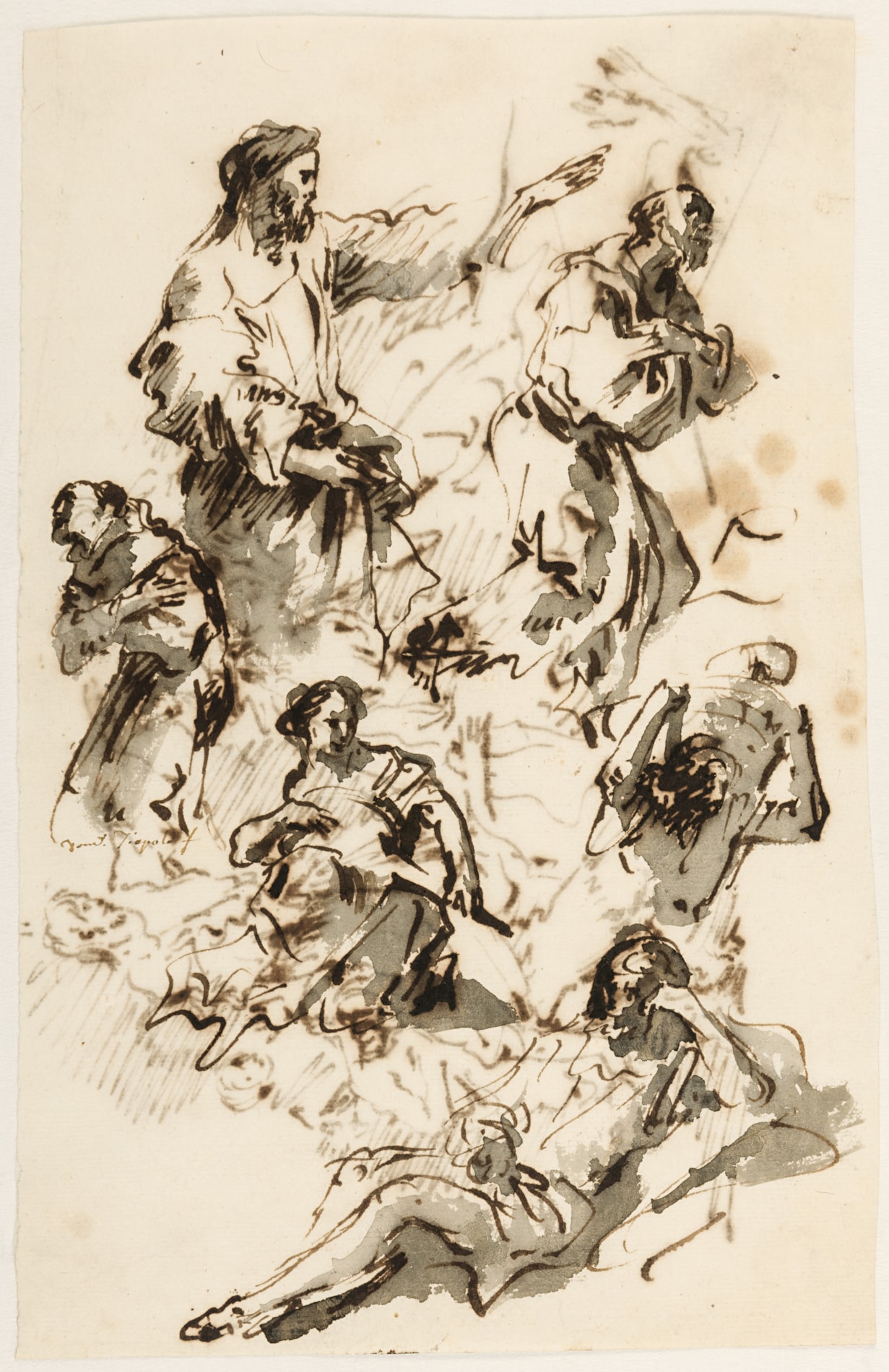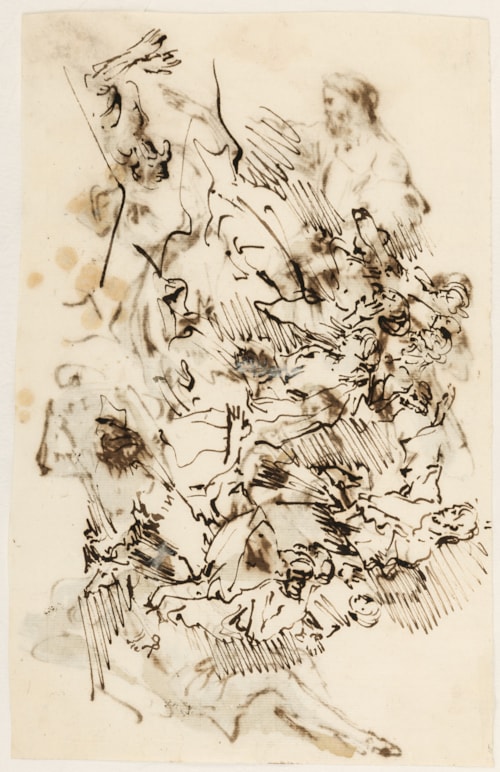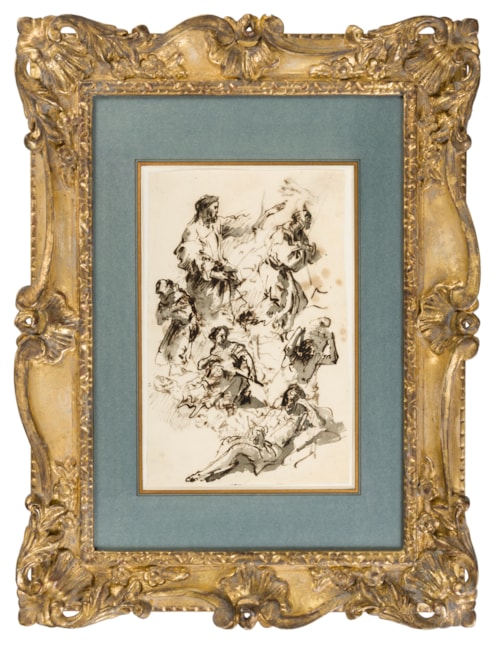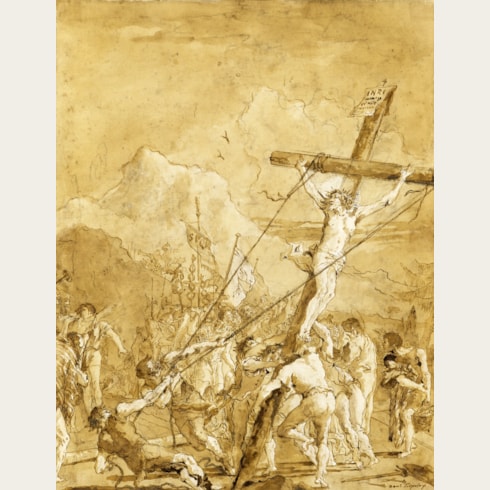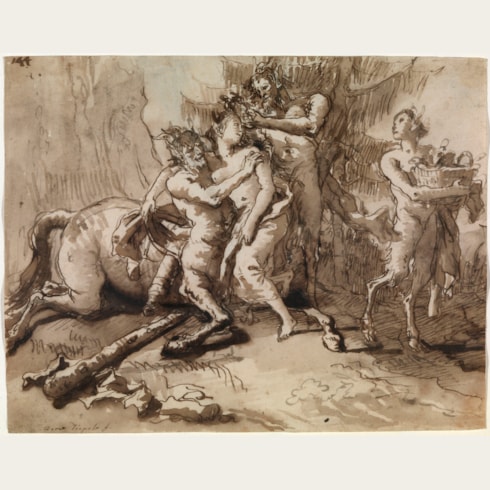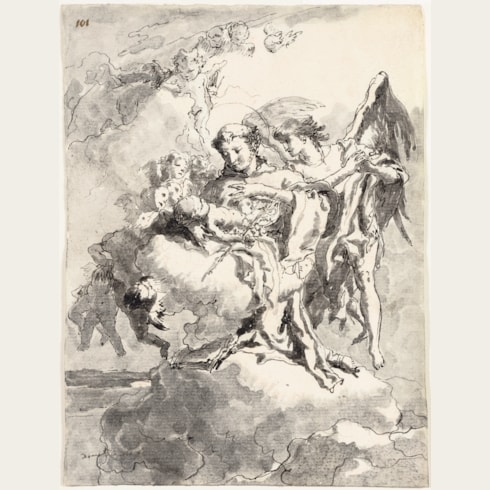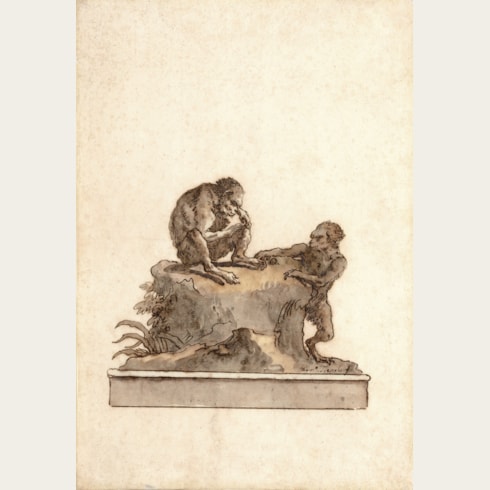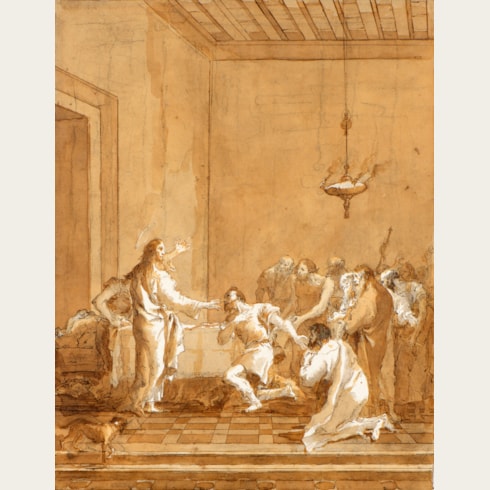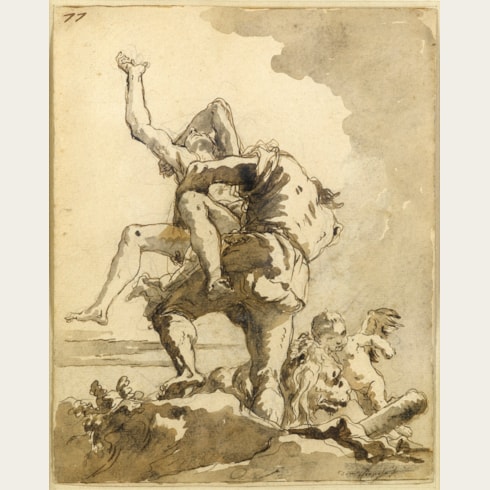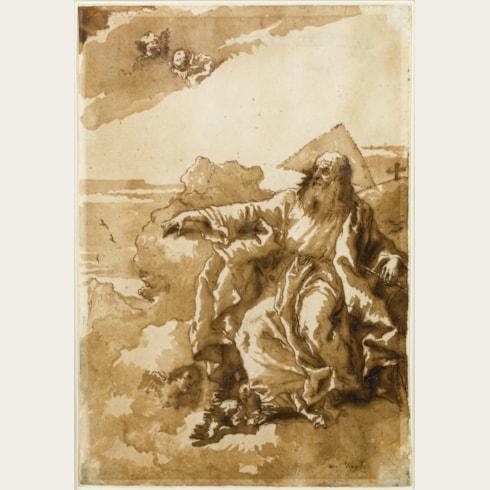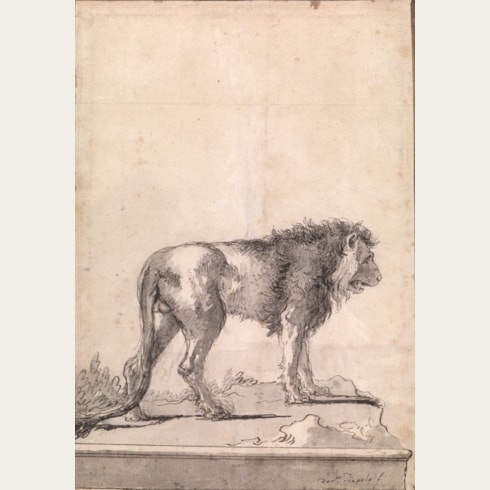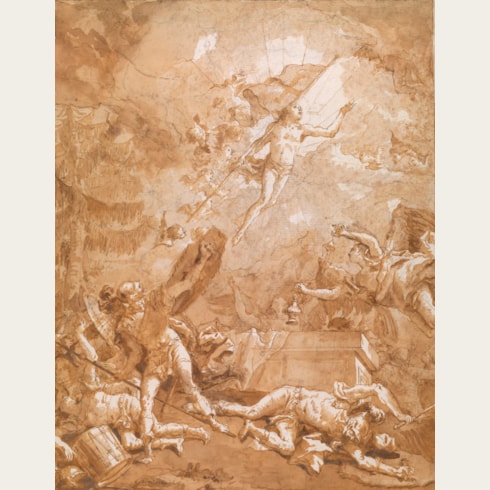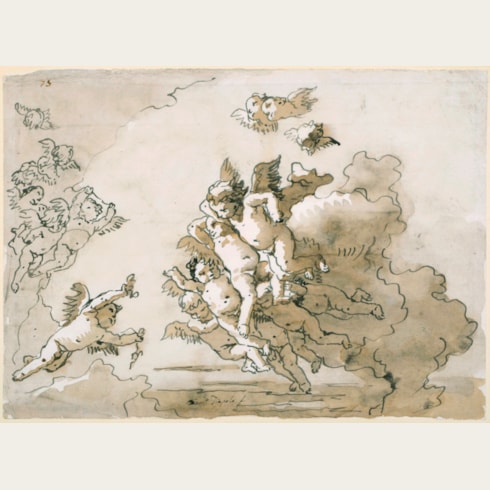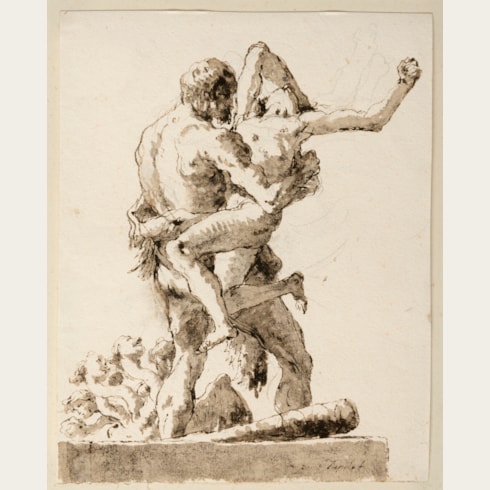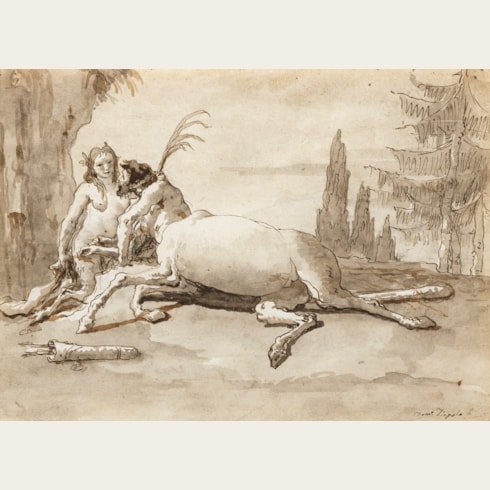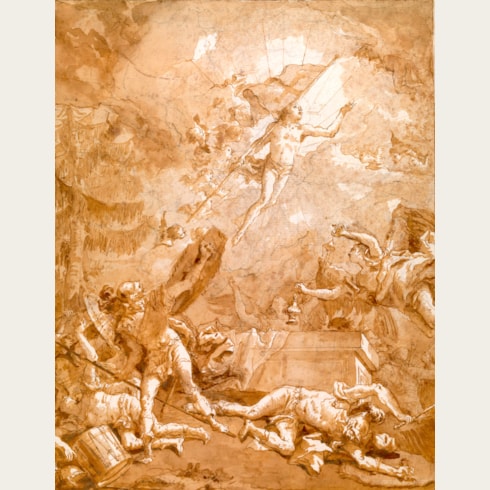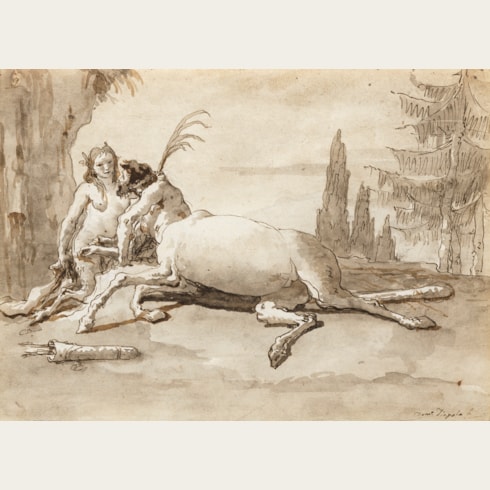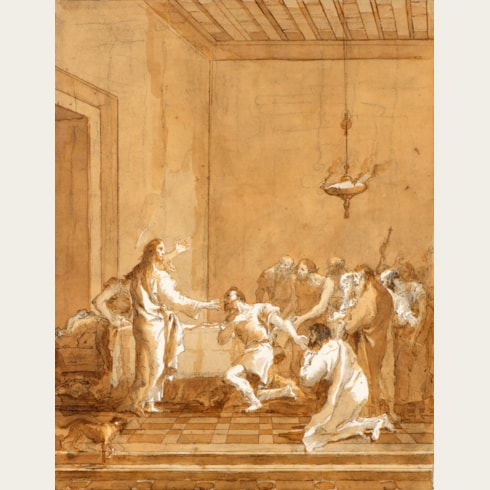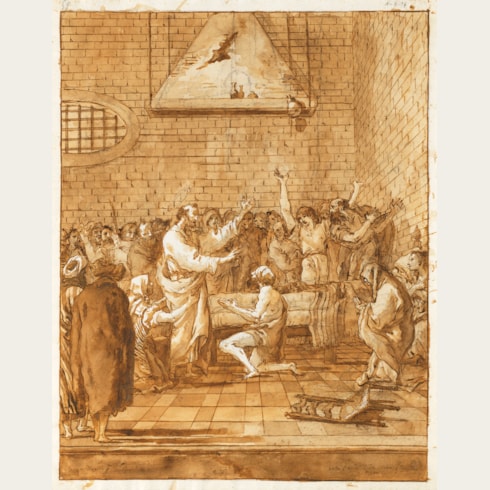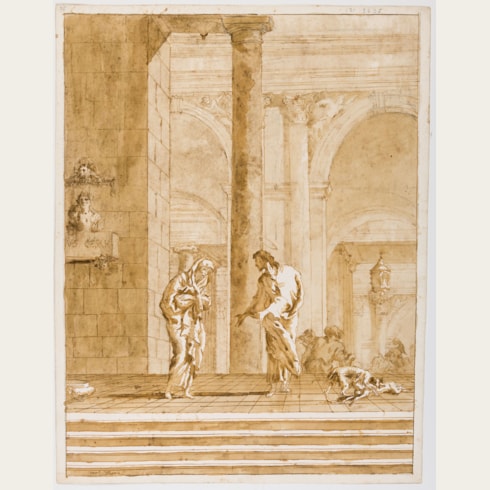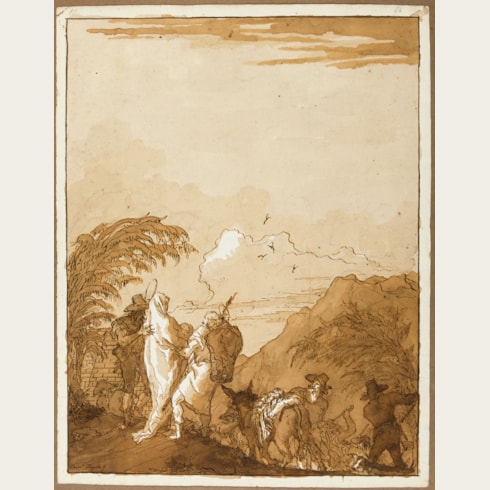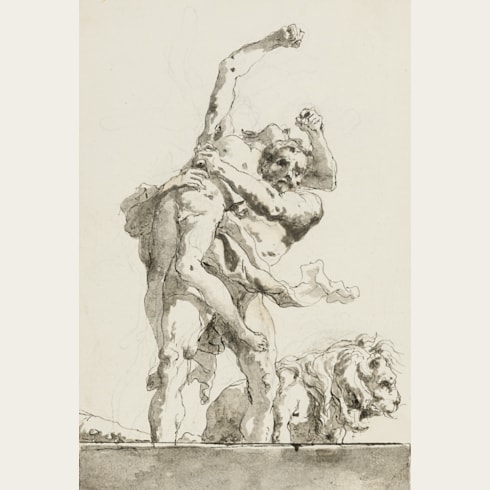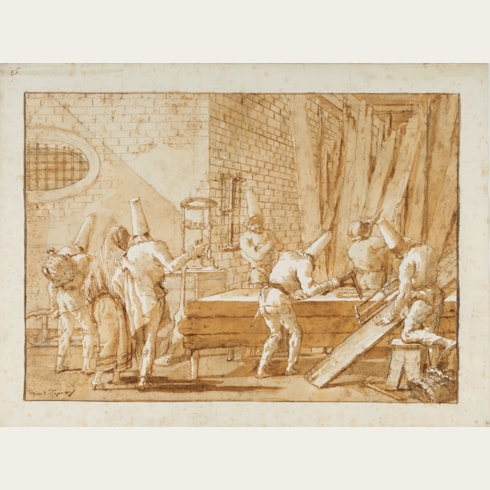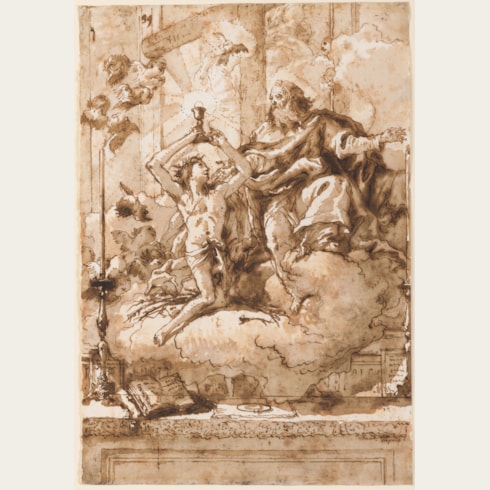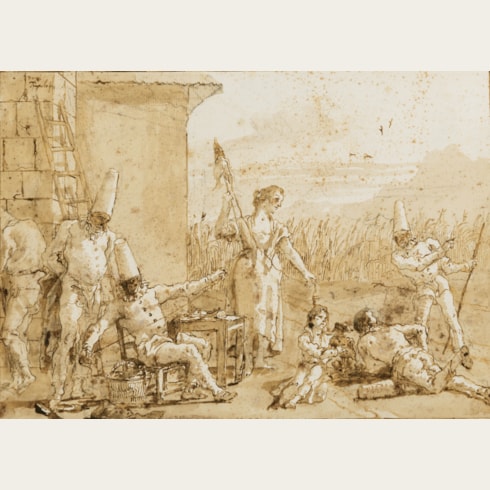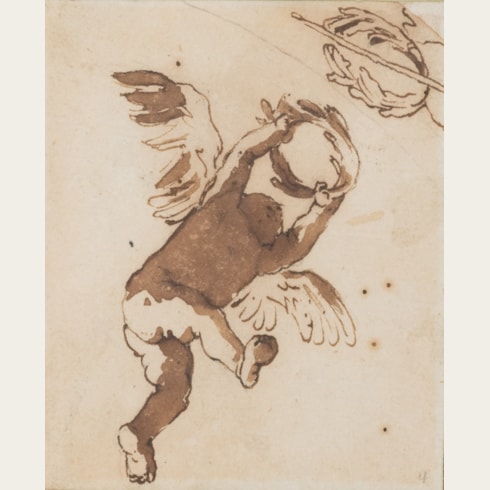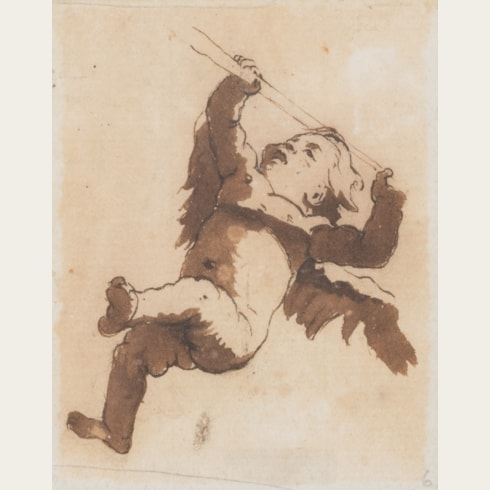Giovanni Domenico TIEPOLO
(Venice 1727 - Venice 1804)
Sheet of Studies of Christ Preaching, Two Monks in Adoration, A Young Woman Kneeling and Holding a Mandolin, A Man Carrying a Heavy Load on his Shoulders and a Reclining Figure [recto]; The Raising of Lazarus, after Giovanni Benedetto Castiglione [verso]
The verso in pen and brown ink.
Signed Dom.o Tiepolo f at the left centre.
270 x 174 mm. (10 5/8 x 6 7/8 in.)
The drawing on the verso of the sheet is a free copy, in reverse, of the composition of a brush drawing of The Raising of Lazarus by the 17th century Genoese artist Giovanni Benedetto Castiglione (1609-1664), which is today in the Royal Collection at Windsor Castle. The pointing figure of Christ on the recto of the present sheet is likewise derived from the same figure in Castiglione’s drawing, which was part of a group of drawings by the artist, bound into four volumes, that belonged to the Sagredo family in Venice in the 18th century. (The albums later passed into the collection of Joseph Smith, the British Consul in Venice, who sold them with the rest of his collection to King George III in 1762.) Although Domenico Tiepolo may have had access to the Sagredo volumes of drawings by Castiglione before they left for England in 1762, it is perhaps more likely that this drawing was based on Castiglione’s reversed monotype of the same composition. Domenico is known to have owned several prints by Castiglione, and both he and his father copied motifs from the Genoese artist’s prints in their drawings.
Stylistically comparable drawings by Domenico Tiepolo include a sheet of sketches with a Flight into Egypt in the Musée des Beaux-Arts et d’Archéologie in Besançon and a capriccio composition in the Museo Civico Sartorio in Trieste, as well as a Scene from the Life of Christ in the Graphische Sammlung in Stuttgart.
The present sheet was at one time part of an album of more than one hundred and sixty drawings by Domenico Tiepolo. The cover of the album bore the title ‘DISEGNI A PENA DA CUADRETTI GIO: DOMENICO FIGLIO DI GIO: BATA’: TIEPOLO CON ALCUNI DISEGNI DEL SUDETTO’, while the inside back cover was inscribed in an 18th century Italian hand - possibly that of the artist Francesco Guardi - ‘Questi Disegni Sono no.160. tutti Originali Costa Cechini 15 da Lire 22 L’uno.’ A very similar inscription is found on two other albums containing drawings by both Giambattista and Domenico Tiepolo - the Quaderno Gatteri in the Museo Correr in Venice and the Beurdeley Album in the Hermitage in St. Petersburg - and it has been suggested that all three albums may have been in the possession of Domenico’s uncle, the Venetian view painter Francesco Guardi (1712-1793), who was offering them for sale in the 1780s or early 1790s. Certainly, the album from which the present sheet comes can be shown to have been sold during Domenico Tiepolo’s lifetime, since the title page – which is inscribed ‘162 Dessin de Dominique Tiepolo fils de Jean Baptiste Tiepolo Venetien’ - bore the bookplate of Horace Walpole, 4th Earl of Orford (1717-1797), who died when the Venetian artist was seventy years old and still active. The album later entered the collections of the Earls Beauchamp, and was broken up and the drawings dispersed at auction in 1965.
Giovanni Domenico Tiepolo is assumed to have begun his career in the family studio by copying his father’s drawings, although he also created his own drawings as designs for etchings, a practice which occupied much of his time in the 1740s and 1750s. His first independent drawings for paintings are those related to a series of fourteen paintings of the Stations of the Cross for the Venetian church of San Polo, completed when he was just twenty. Between 1750 and 1770, Domenico worked closely with his father as an assistant, notably in Würzburg, at the Villa Valmarana in Vicenza and the Villa Pisani at Strà, and in Madrid. From the late 1740s he also began to be entrusted with his own independent commissions, and the drawings for these display a manner somewhat different from that of his father, with a particular interest in lighthearted genre motifs.
Soon after Giambattista Tiepolo’s sudden death in Madrid in 1770, Domenico returned to his native Venice, where he enjoyed much success as a decorative painter. He continued to expound the grand manner of history painting established by his father - the ‘Tiepolo style’, as it were – and by 1780 his reputation was such that he was named president of the Accademia di Belle Arti in Venice. Within a few years, however, he seems to have largely abandoned painting. In his sixties and living effectively in retirement at the Tiepolo family villa at Zianigo, on the Venetian mainland, he produced a large number of pen and wash drawings that are a testament to his inexhaustible gift for compositional invention.
For much of the last twenty years of his career, Domenico Tiepolo seems to have painted only occasionally, and instead worked primarily as a draughtsman, producing a large number of pen and wash drawings that may collectively be regarded as perhaps his finest artistic legacy. These drawings were, for the most part, executed as a series of several dozen or more themed drawings, many of which were numbered. Among these are several series of drawings of religious and mythological subjects, as well as a varied group of genre scenes, numbering around a hundred sheets, generally referred to as the so-called ‘Scenes of Contemporary Life’, and a celebrated series of 104 drawings entitled the Divertimenti per li regazzi, illustrating scenes from the life of Punchinello, a popular character from the Commedia dell’Arte.
Domenico’s highly finished late drawings, almost all of which were signed, were undoubtedly intended as fully realized, autonomous works of art. While it is certainly possible that they were produced as works of art to be offered for sale to collectors, almost none of the drawings appear to have been dispersed in Domenico’s lifetime. The fact, too, that many of the drawings are numbered, possibly by the artist himself, and that most remained together in groups for many years after his death, would also suggest that they were retained in his studio throughout his life, as indeed he also kept numerous albums of drawings by his father. It is most likely, therefore, that these late drawings by Domenico were done simply for his own pleasure. Nevertheless, they have consistently enjoyed immense popularity since the artist’s death, and continue to entice collectors today. As Catherine Whistler has noted, ‘Domenico’s spirited and inventive independent sheets have long been appreciated, particularly by French and American collectors of the late nineteenth and early twentieth centuries; his quirky sense of humor, acutely observant eye, and zestful approach to his subjects lend his drawings a peculiarly modern appeal.’
As Michael Levey has also noted of the artist, ‘Domenico Tiepolo’s drawings provide us with the more private side of him, but they also serve to represent his career at all stages. He drew continually: sometimes very closely in the manner of his father; at the opposite remove, in the late Punchinello drawings for example, his manner and matter could never be mistaken for anyone else’s...The key to Domenico is in drawings: he began as a draughtsman and, one is tempted to say, all his paintings betray the draughtsman.’
Provenance
Possibly the artist’s uncle, Francesco Guardi, Venice
Horace Walpole, 4th Earl of Orford, London and Strawberry Hill, Twickenham, Middlesex
William Lygon, 8th Earl Beauchamp, Madresfield Court, Worcestershire
His sale, London, Christie’s, 15 June 1965, lot 165 (bt. Calmann for 220 gns.)
Hans Calmann, London
Acquired from him in 1965 by Robert Landolt, Chur
Thence by descent.
Literature
Exhibition

